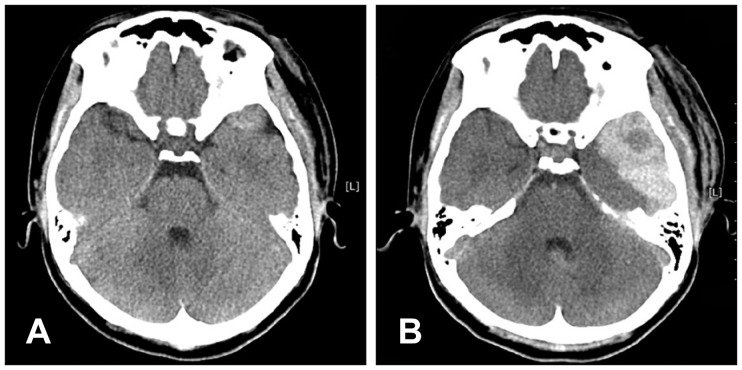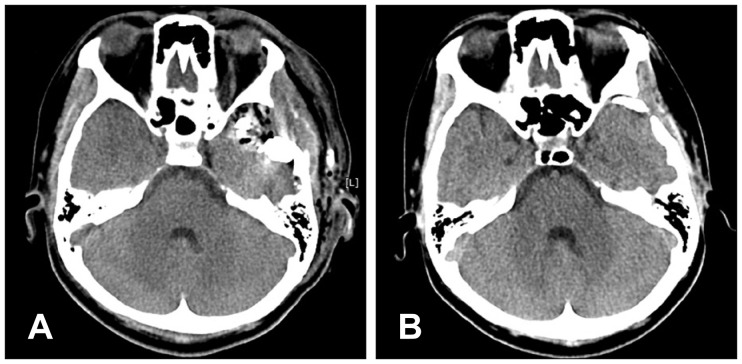Korean J Neurotrauma.
2015 Oct;11(2):167-169. 10.13004/kjnt.2015.11.2.167.
Intraoperative Endovascular Embolization of Middle Meningeal Artery and a Pseudoaneurysm by Using N-Butyl 2-Cyanoacrylate for Hemostasis during Operation of Acute Epidural Hemorrhage
- Affiliations
-
- 1Department of Neurosurgery, Hallym University College of Medicine, Kangdong Sacred Heart Hospital, Seoul, Korea. nsyjlee@gmail.com
- KMID: 2378280
- DOI: http://doi.org/10.13004/kjnt.2015.11.2.167
Abstract
- A 21-year-old female presented with acute epidural hemorrhage (EDH) on the left temporal region associated with skull fracture after traffic accident. She was neurologically deteriorated at four-hour after an admission, and follow-up computed tomography revealed increased amount of EDH. Under the general anesthesia, emergency craniotomy was performed. During the surgery, massive bleeding from the base of middle cranial fossa was observed. However, we could not identify an origin of bleeding and foramen spinosum due to brain swelling and obscured surgical field. Consequently, her systolic blood pressure was dropped to 60 mm Hg with >110 beat/min of heart rate. Therefore, we decided to perform an intraoperative angiography after gauze packing into the middle cranial fossa. Intraoperative angiography showed a large pseudoaneurysm with massive contrast leakage of the middle meningeal artery (MMA). Intraoperative endovascular embolization of the pseudoaneurysm and MMA by using n-butyl-2-cyanoacrylate was done. After that, her vital sign became stable, and we could complete the operation after the achievement of adequate hemostasis. Intraoperative angiography and endovascular embolization of MMA was effective in achieving adequate hemostasis in case with brisk bleeding from the middle cranial fossa could not be controlled in an open surgical field.
MeSH Terms
Figure
Cited by 1 articles
-
Traumatic middle meningeal artery pseudoaneurysm: Case report and review of literature
Nadeem Mohammed, Harsh Deora, Abhinith Shashidhar, Malla Bhaskara Rao
J Cerebrovasc Endovasc Neurosurg. 2025;27(1):60-65. doi: 10.7461/jcen.2024.E2024.04.004.
Reference
-
1. Bullock MR, Chesnut R, Ghajar J, Gordon D, Hartl R, Newell DW, et al. Surgical management of acute epidural hematomas. Neurosurgery. 2006; 58(3 Suppl):S7–S15. discussion Si-SivPMID: 16710967.
Article2. de Andrade AF, Figueiredo EG, Caldas JG, Paiva WS, De Amorim RL, Puglia P, et al. Intracranial vascular lesions associated with small epidural hematomas. Neurosurgery. 2008; 62:416–420. discussion 420-421PMID: 18382319.
Article3. Jussen D, Wiener E, Vajkoczy P, Horn P. diagnosis and endovascular treatment of two cases and review of the literature. Neuroradiology. 2012; 54:1133–1136. PMID: 22218611.4. Kinoshita Y, Yasukouchi H, Tsuru E, Okudera T, Yokota A. [Delayed epidural bleeding caused by traumatic pseudoaneurysm of the middle meningeal artery: case report]. No Shinkei Geka. 2004; 32:1139–1143. PMID: 15570878.5. Lammy S, McConnell R, Kamel M, Rennie I, Al-Haddad S.is there a role for endovascular treatment? Br J Neurosurg. 2013; 27:383–385. PMID: 22946965.6. Lim DH, Kim TS, Joo SP, Kim SH. Intracerebral hematoma caused by ruptured traumatic pseudoaneurysm of the middle meningeal artery: a case report. J Korean Neurosurg Soc. 2007; 42:416–418. PMID: 19096582.7. Pascual JM, Prieto R. Surgical management of severe closed head injury in adults. In : Quinones-Hinojosa A, editor. Schmidek and sweet operative neurosurgical techniques. ed 6. Philadelphia, PA: Elsevier;2012. p. 1513–1538.8. Suzuki S, Endo M, Kurata A, Ohmomo T, Oka H, Kitahara T, et al. Efficacy of endovascular surgery for the treatment of acute epidural hematomas. AJNR Am J Neuroradiol. 2004; 25:1177–1180. PMID: 15313705.
- Full Text Links
- Actions
-
Cited
- CITED
-
- Close
- Share
- Similar articles
-
- Angiographically Progressive Change of Traumatic Pseudoaneurysm Arising from the Middle Meningeal Artery
- Middle meningeal artery embolizationto treat progressive epidural hematoma:a case report
- Percutaneous N-Butyl Cyanoacrylate Embolization of a Pancreatic Pseudoaneurysm after Failed Attempts of Transcatheter Embolization
- Rupture of a Middle Meningeal Artery Pseudoaneurysm in Moyamoya Syndrome Related with Tuberculous Meningitis
- Inferior Mesenteric Artery Embolization with N-Butyl Cyanoacrylate for Life-Threatening Postpartum Hemorrhage: A Report of Two Cases and Literature Review




